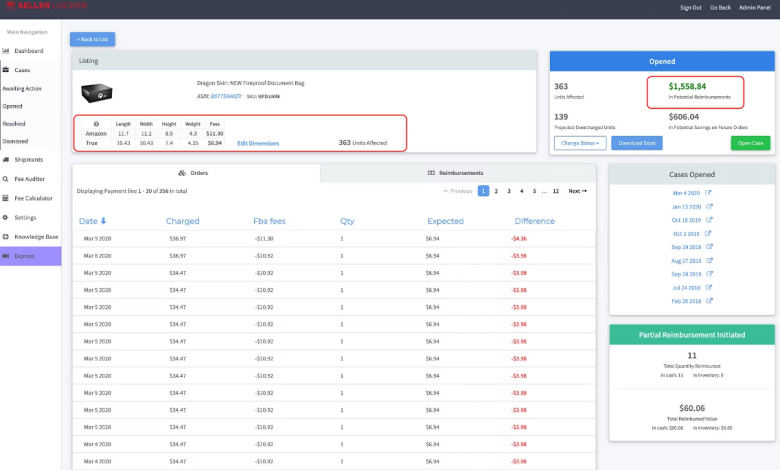Navigating Amazon Reimbursement Processes: Best Practices for Sellers

Selling on Amazon involves more than just listing products and managing sales. It requires navigating various operational aspects, including managing reimbursements for issues that affect inventory and financial transactions. Amazon’s reimbursement processes are designed to help sellers recover funds for situations such as lost or damaged inventory, overcharged fees, or unresolved customer returns. Understanding these processes and implementing best practices can significantly impact a seller’s financial health and operational efficiency on the platform. This guide provides essential insights and strategies for sellers to navigate amazon reimbursement processes effectively.
Understanding Amazon Reimbursement
Amazon reimbursement refers to the process through which sellers can request compensation for financial losses incurred due to specific issues related to their business operations on the platform. Key reasons for seeking reimbursement include:
- Lost or Damaged Inventory: Inventory stored in Amazon’s fulfillment centers that becomes lost or damaged.
- Overcharged Fees: Errors in fee calculations resulting in excessive charges by Amazon.
- Customer Returns: Instances where customers return items, but the seller does not receive the returned product or refund.
Importance of Navigating Amazon Reimbursement Processes
Effectively navigating Amazon reimbursement processes is essential for sellers to:
- Maintain Financial Health: Recovering funds promptly helps sellers maintain profitability and cash flow.
- Optimize Operational Efficiency: Efficient reimbursement processes minimize disruptions and improve overall business efficiency.
- Enhance Seller Performance: Resolving reimbursement issues positively impacts seller metrics and reputation on Amazon.
Best Practices for Navigating Amazon Reimbursement Processes
Navigating Amazon reimbursement processes requires a systematic approach and adherence to best practices. Implementing these strategies can help sellers streamline operations and maximize their reimbursement outcomes:
Familiarize Yourself with Amazon’s Reimbursement Policies
Thoroughly review Amazon’s reimbursement policies and guidelines available on Seller Central. Understand eligibility criteria, submission timelines, and documentation requirements specific to each reimbursement category.
Regularly Monitor Inventory and Transactions
Consistently monitor inventory levels, transaction reports, and fee statements through Seller Central. Proactively identify discrepancies such as lost inventory, overcharged fees, or unresolved returns that may necessitate reimbursement claims.
Maintain Detailed Documentation
Maintain meticulous records of all transactions, inventory movements, and communications related to reimbursement issues. Organize documentation systematically to facilitate the preparation and submission of reimbursement claims.
Utilize Amazon’s Automated Tools and Reports
Leverage Amazon’s automated tools and reports available in Seller Central to streamline the reimbursement process:
- Inventory Adjustments Report: Identify discrepancies in inventory levels and initiate claims for lost or damaged inventory.
- FBA Lost and Damaged Inventory Reimbursement Tool: Simplify the process of submitting claims for lost or damaged inventory stored in Amazon’s fulfillment centers.
Submit Accurate and Timely Claims
Ensure all reimbursement claims submitted to Amazon are accurate, well-documented, and submitted within the specified timelines. Include comprehensive details and supporting evidence to substantiate the claim effectively.
Steps to Navigate Amazon Reimbursement Processes Successfully
Follow these steps to navigate Amazon reimbursement processes successfully and optimize your reimbursement outcomes:
Identify Eligible Issues
Identify specific issues that qualify for reimbursement under Amazon’s policies, such as lost inventory, overcharged fees, or unresolved customer returns.
Gather Supporting Documentation
Collect comprehensive documentation to support your reimbursement claim, including transaction reports, inventory adjustment reports, and communication records with Amazon support.
Initiate the Reimbursement Claim
Navigate to Seller Central, select the appropriate reimbursement category, provide detailed information, and upload supporting documentation to initiate your reimbursement claim.
Monitor Claim Progress
Regularly monitor the status of your reimbursement claim through Seller Central’s Case Log. Respond promptly to any requests from Amazon for additional information or clarification.
Review Amazon’s Decision
Once Amazon reviews your reimbursement claim, they will either approve or deny the reimbursement. Carefully review their decision, provide any necessary additional information, or escalate the claim if needed.
Best Practices for Optimizing Amazon Reimbursement
Adopting best practices enhances your efficiency and success with amazon reimbursement processes:
- Maintain Transparent Communication: Maintain open communication with Amazon Seller Support and promptly respond to inquiries or requests related to reimbursement claims.
- Stay Informed: Stay updated on Amazon’s reimbursement policies, changes, and updates to ensure compliance and maximize reimbursement potential.
- Track Reimbursement Payments: Monitor reimbursement payments credited to your account and reconcile them with your reimbursement claims to ensure accuracy and completeness.
Conclusion
Navigating Amazon reimbursement processes effectively is crucial for sellers to recover funds promptly and maintain financial health on the platform. By understanding Amazon’s reimbursement policies, implementing effective strategies, and following a systematic approach to claims management, sellers can optimize reimbursement outcomes and enhance their overall selling experience.
By leveraging the strategies and best practices outlined in this guide, sellers can navigate Amazon reimbursement processes with confidence, ensuring they maximize their reimbursement potential and maintain operational efficiency.









